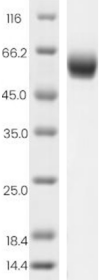Mouse CD270 Protein, Fc Tag
-
产品编号
KMP2369
-
别名
疱疹病毒入侵介质蛋白, Tumor Necrosis Factor Receptor Superfamily Member 14, CD270
-
规格
- 50ug
- 100ug
- 200ug
| Catalog Number | KMP2369 |
| Alias | 疱疹病毒入侵介质蛋白, Tumor Necrosis Factor Receptor Superfamily Member 14, CD270 |
| Size | 50ug, 100ug, 200ug |
| Product Description | The Mouse CD270 Protein(KMP2369) is produced in HEK293 Cells and the target gene encoding Gln39-Val207 is expressed with a Fc tag at the C-terminus. |
| Molecular Name | CD270 |
| Product Introduction | CD270(HVEM):TNF受体超家族成员,以跨膜形式参与多种免疫细胞间的信号传导。 |
| Molecular Weight | 19.26 kDa |
| Expression System | HEK293 Cells |
| Species | Mouse |
| Purity | >95% |
| SDS-PAGE |  |
| Purification | Affinity Purification |
| Uniprot ID | Q92956 |
| Storage Condition | Aliquot and store at -20℃ to -80℃. Avoid repeated freezing and thawing cycles. |
| Formulation | PBS, pH7.4 |
| Shipping Condition | In general, the proteins are provided as lyophilized powder which are shipped at ambient temperature. They are shipped out in dry ice if supplied in liquid form. |
| Background | Mouse Protein Tnfrsf14, is a type I transmembrane protein belonging to the TNF receptor superfamily. It is tumor necrosis factor receptor superfamily member 14 and expressed on the surface of T cells during the resting state. Interaction of HVEM with TNF family member LIGHT co-stimulates T cells and promotes inflammation. HVEM also triggers inhibitory signaling cascade in effector T(Teff) cells and regulatory T cells(Tregs) as a ligand of B and T lymphocyte attenuator. Tnfrsf14 is detected in peripheral blood T cells, B cells, monocytes and in various tissues enriched in lymphoid cells. It has demonstrated that HVEM Ig is able to exert a significant antiviral effect against HSV-1 infection in vivo. |
| Endotoxin | <1.0 EU/ug determined by the LAL method |
| Product Declaration | 该产品仅供科研使用,不可直接用于人体或注射。 |
蛋白可以在-80°C下储存以便长期保存。应分装并避免冻融循环,以保持蛋白的稳定性。
可以通过优化质粒设计、使用高效转染试剂、优化细胞培养条件以及使用蛋白折叠伴侣或密码子优化来提高蛋白表达效率。





 0
0
